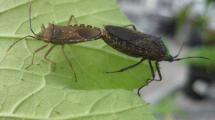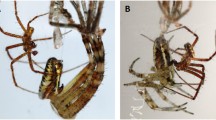Abstract
The orb-web spider genus Argiope (Araneae ) offers an excellent opportunity to detect cryptic female choice and to identify the species-specific traits that might lead to its evolution and maintenance. All studied species of the genus Argiope are characterized by low male mating rates . While males of some species are strictly mono- or bigynous , others plastically switch between these two strategies. All studied species show sexual cannibalism during copulation. Generally, males die after their second copulation, but the probability of surviving the first copulation differs considerably between species and so does copulation duration . Males of most species break off pieces of their genitalia during copulation that act as mating plugs, but how often this occurs and how effective these plugs are is highly variable. Females that mate multiply can influence the relative paternity success of males through their partial control of copulation duration and their likely control of sperm storage . There is evidence that females cryptically favor small males over large ones, unrelated males over siblings, and males that courted over those that do not. We will sketch variation within and between species in mating systems and related traits, and we will discuss how this relates to cryptic female choice . We will review the existing evidence for cryptic female choice and suggest future avenues in elucidating possible mechanisms that facilitate cryptic female choice and the cues that females may base their choices on.
Access this chapter
Tax calculation will be finalised at checkout
Purchases are for personal use only
Similar content being viewed by others
References
Chapman T (2006) Evolutionary conflicts of interest between males and females. Curr Biol 16(17):R744–R754
Chapman T, Arnqvist G, Bangham J, Rowe L (2003) Sexual conflict. Trends Ecol Evol 18(1):41–47
Cheng RC, Kuntner M (2014) Phylogeny suggests nondirectional and isometric evolution of sexual size dimorphism in argiopine spiders. Evolution 68–10:2861–2872
Chinta SP, Goller S, Lux J, Funke S, Uhl G, Schidz S (2010) The sex pheromone of the wasp spider Argiope bruennichi. Angew Chem Int Edit 49(11):2033–2036
Danielsson I (2001) Antagonistic pre- and post-copulatory sexual selection on male body size in a water strider (Gerris lacustris). Proc R Soc B Biol Sci 268(1462):77–81
Eberhard WG (1996) Female control: sexual selection by cryptic female choice. Princeton University Press, Princeton
Elgar MA (1991) Size dimorphism in sexually cannibalistic orb-weaving spiders covaries with courtship behaviour. Evolution 45:444–448
Elgar MA, Schneider JM, Herberstein ME (2000) Female control of paternity in the sexually cannibalistic spider Argiope keyserlingi. Proc R Soc B Biol Sci 267(1460):2439–2443
Foellmer MW (2008) Broken genitals function as mating plugs and affect sex ratios in the orb-web spider Argiope aurantia. Evol Ecol Res 10(3):449–462
Foellmer MW, Fairbairn DJ (2003) Spontaneous male death during copulation in an orb-weaving spider. Proc R Soc B Biol Sci 270:S183–S185
Foellmer MW, Fairbairn DJ (2004) Males under attack: sexual cannibalism and its consequences for male morphology and behaviour in an orb-weaving spider. Evol Ecol Res 6(2):163–181
Fromhage L, Elgar MA, Schneider JM (2005) Faithful without care: the evolution of monogyny. Evolution 59(7):1400–1405
Fromhage L, McNamara JM, Houston AI (2008) A model for the evolutionary maintenance of monogyny in spiders. J Theor Biol 250(3):524–531
Fromhage L, Schneider JM (2012) A mate to die for? A model of conditional monogyny in cannibalistic spiders. Ecol Evol 2(10):2572–2582
Fromhage L, Uhl G, Schneider JM (2003) Fitness consequences of sexual cannibalism in female Argiope bruennichi. Behav Ecol Sociobiol 55(1):60–64
Gaskett AC (2007) Spider sex pheromones: emission, reception, structures, and functions. Biol Rev 82(1):26–48
Gaskett AC, Herberstein ME, Downes BJ, Elgar MA (2004) Changes in male mate choice in a sexually cannibalistic orb-web spider (Araneae: Araneidae). Behaviour 141:1197–1210
Ghione S, Costa FG (2011) Female attack is not necessary for male copulatory organ breakage in the sexually cannibalistic spider Argiope argentata (Araneae: Araneidae). J Arachnol 39(1):197–200
Grasshoff M (1973) Bau und Mechanik der Kopulationsorgane der Radnetzspinne Mangora acalypha (Arachnids, Araneae). Zeitschrift für Morphologie der Tiere 74(3):241–252
Herberstein ME, Barry KL, Turoczy MA, Wills E, Youssef C, Elgar MA (2005a) Post-copulation mate guarding in the sexually cannibalistic St Andrew’s cross spider (Araneae Araneidae). Ethol Ecol Evol 17(1):17–26
Herberstein ME, Gaskett AC, Schneider JM, Vella NGF, Elgar MA (2005b) Limits to male copulation frequency: sexual cannibalism and sterility in St Andrew’s cross spiders (Araneae, Araneidae). Ethology 111(11):1050–1061
Herberstein ME, Schneider JM, Elgar MA (2002) Costs of courtship and mating in a sexually cannibalistic orb-web spider: female mating strategies and their consequences for males. Behav Ecol Sociobiol 51(5):440–446
Herberstein ME, Schneider JM, Harmer AMT, Gaskett AC, Robinson K, Shaddick K, Soetkamp D, Wilson PD, Pekar S, Elgar MA (2011a) Sperm storage and copulation duration in a sexually cannibalistic spider. J Ethol 29(1):9–15
Herberstein ME, Schneider JM, Uhl G, Michalik P (2011b) Sperm dynamics in spiders. Behav Ecol 22(4):692–695
Herberstein ME, Wignall AE, Nessler SH, Harmer AMT, Schneider JM (2012) How effective and persistent are fragments of male genitalia as mating plugs? Behav Ecol 23(5):1140–1145
Hosken DJ, Blanckenhorn WU, Garner TWJ (2002) Heteropopulation males have a fertilization advantage during sperm competition in the yellow dung fly (Scathophaga stercoraria). Proc R Soc B Biol Sci 269(1501):1701–1707
Hosken DJ, Stockley P (2004) Sexual selection and genital evolution. Trends Ecol Evol 19(2):87–93
Hosken DJ, Taylor ML, Hoyle K, Higgins S, Wedell N (2008) Attractive males have greater success in sperm competition. Curr Biol 18(13):R553–R554
Jäger P (2012) Review on the spider genus Argiope Audoin 1826 with special emphasis on broken emboli in female epigynes (Araneae: Araneidae: Argiopinae). Beiträge zur Araneologie 7:272–331
Levi HW (1968) The spider genera Gea and Argiope in America. Bull Mus Comp Zool 136:319–352
Levi HW (1983) The orb-weaver genera Argiope, Gea and Neogea from the Western Pacific region (Araneae: Araneidae, Argiopinae). Bull Mus Comp Zool 150:247–338
Michalik P, Rittschof CC (2011) A comparative analysis of the morphology and evolution of permanent sperm depletion in spiders. Plos One 6(1). doi:10.1371/journal.pone.0016014
Miller JA (2007) Repeated evolution of male sacrifice behavior in spiders correlated with genital mutilation. Evolution 61(6):1301–1315
Nessler S (2009) Adaptive value of male genital mutilation, sexual cannibalism, and mating strategies in the orb-weaving spider genus Argiope (Araneae: Araneidae). University of Hamburg, Hamburg
Nessler S, Uhl G, Schneider J (2009a) Sexual cannibalism facilitates genital damage in Argiope lobata (Araneae: Araneidae). Behav Ecol Sociobiol 63(3):355–362
Nessler SH, Uhl G, Schneider JM (2007a) Genital damage in the orb-web spider Argiope bruennichi (Araneae: Araneidae) increases paternity success. Behav Ecol 18(1):174–181
Nessler SH, Uhl G, Schneider JM (2007b) A non-sperm transferring genital trait under sexual selection: an experimental approach. Proc R Soc B Biol Sci 274(1623):2337–2341
Nessler SH, Uhl G, Schneider JM (2009b) Scent of a woman—the effect of female presence on sexual cannibalism in an orb-weaving spider (Araneae: Araneidae). Ethology 115(7):633–640
Prenter J, MacNeil C, Elwood RW (2006) Sexual cannibalism and mate choice. Anim Behav 71:481–490
Robinson MH, Robinson B (1980) Comparative studies of the courtship and mating behaviour of tropical araneid spiders. Pacific Insects Monogr 36:1–218
Sasaki T, Iwahashi O (1995) Sexual cannibalism in an orb-weaving spider Argiope aemula. Anim Behav 49(4):1119–1121
Schneider J, Fromhage L (2010) Monogynous mating strategies in spiders. In: Kappeler P (ed) Animal behaviour: evolution and mechanisms. Springer, Heidelberg, pp 441–464
Schneider JM (2014) Sexual cannibalism as a manifestation of sexual conflict. In: Rice RW, Gavrilets S (eds) The genetics and biology of sexual conflict. Cold spring harbor perspectives in biology. Cold Spring Harbor Laboratory Press, New York
Schneider JM, Andrade MCB (2011) Mating behaviour and sexual selection. In: Herberstein M (ed) Spider behaviour: flexibility and versatility. Cambridge University Press, Cambridge, pp 215–274
Schneider JM, Fromhage L, Uhl G (2005) Extremely short copulations do not affect hatching success in Argiope bruennichi (Araneae, Araneidae). J Arachnol 33(3):663–669
Schneider JM, Gilberg S, Fromhage L, Uhl G (2006) Sexual conflict over copulation duration in a cannibalistic spider. Anim Behav 71:781–788
Schneider JM, Lesmono K (2009) Courtship raises male fertilization success through post-mating sexual selection in a spider. Proc R Soc B Biol Sci 276(1670):3105–3111
Schneider JM, Michalik P (2011) One-shot genitalia are not an evolutionary dead end—regained male polygamy in a sperm limited spider species. BMC Evol Biol 11:197
Schulte KF, Uhl G, Schneider JM (2010) Mate choice in males with one-shot genitalia: limited importance of female fecundity. Anim Behav 80(4):699–706
Schwartz SK, Wagner WE, Hebets EA (2013) Spontaneous male death and monogyny in the dark fishing spider. Biol Lett 9(4). doi:10.1098/rsbl.2013.0113
Schwartz SK, Wagner WE, Hebets EA (2014) Obligate male death and sexual cannibalism in dark fishing spiders. Anim Behav 93:151–156
Uhl G (1994) Ultrastructure of the accessory glands in female genitalia of Pholcus phalangioides (Fuesslin, 1775) (Pholcidae, Araneae). Acta zool (Stockholm) 75(1):13–25
Uhl G (2000) Two distinctly different sperm storage organs in female Dysdera erythrina (Araneae: Dysderidae). Arthropod Struct Dev 29:163–169
Uhl G, Elias DO (2011) Communication. In: Herberstein M (ed) Spider behaviour: flexibility and versatility. Cambridge University Press, Cambridge, pp 127–189
Uhl G, Nessler S, Schneider J (2010) Securing paternity in spiders? A review on occurrence and effects of mating plugs and male genital mutilation. Genetica 138(1):75–104
Uhl G, Nessler SH, Schneider J (2007) Copulatory mechanism in a sexually cannibalistic spider with genital mutilation (Araneae: Araneidae: Argiope bruennichi). Zoology 110(5):398–408
Vöcking O, Uhl G, Michalik P (2013) Sperm dynamics in spiders (Araneae): ultrastructural analysis of the sperm activation process in the garden spider Argiope bruennichi (Scopoli, 1772). Plos One 8(9). doi:10.1371/journal.pone.0072660
Welke K, Schneider JM (2009) Inbreeding avoidance through cryptic female choice in the cannibalistic orb-web spider Argiope lobata. Behav Ecol 20(5):1056–1062
Welke KW, Schneider JM (2010) Males of the orb-web spider Argiope bruennichi sacrifice themselves to unrelated females. Biol Lett 6(5):585–588
Welke KW, Zimmer SM, Schneider JM (2012) Conditional monogyny: female quality predicts male faithfulness. Front Zool 9. doi:10.1186/1742-9994-9-7
Wignall AE, Herberstein ME (2013a) The influence of vibratory courtship on female mating behaviour in orb-web spiders (Argiope keyserlingi, Karsch 1878). Plos One 8(1). doi:10.1371/journal.pone.0053057
Wignall AE, Herberstein ME (2013b) Male courtship vibrations delay predatory behaviour in female spiders. Sci Rep 3. doi:10.1038/srep03557
Zimmer SM, Schneider JM, Herberstein ME (2014) Can males detect the strength of sperm competition and presence of genital plugs during mate choice? Behav Ecol 25(4):716–722
Zimmer SM, Welke KW, Schneider JM (2012) Determinants of natural mating success in the cannibalistic orb-web spider Argiope bruennichi. Plos One 7(2). doi:10.1371/journal.pone.0031389
Author information
Authors and Affiliations
Corresponding author
Editor information
Editors and Affiliations
Rights and permissions
Copyright information
© 2015 Springer International Publishing Switzerland
About this chapter
Cite this chapter
Schneider, J., Uhl, G., Herberstein, M.E. (2015). Cryptic Female Choice Within the Genus Argiope: A Comparative Approach. In: Peretti, A., Aisenberg, A. (eds) Cryptic Female Choice in Arthropods. Springer, Cham. https://doi.org/10.1007/978-3-319-17894-3_3
Download citation
DOI: https://doi.org/10.1007/978-3-319-17894-3_3
Published:
Publisher Name: Springer, Cham
Print ISBN: 978-3-319-17893-6
Online ISBN: 978-3-319-17894-3
eBook Packages: Biomedical and Life SciencesBiomedical and Life Sciences (R0)




